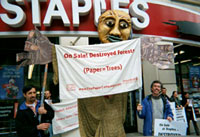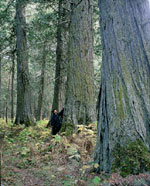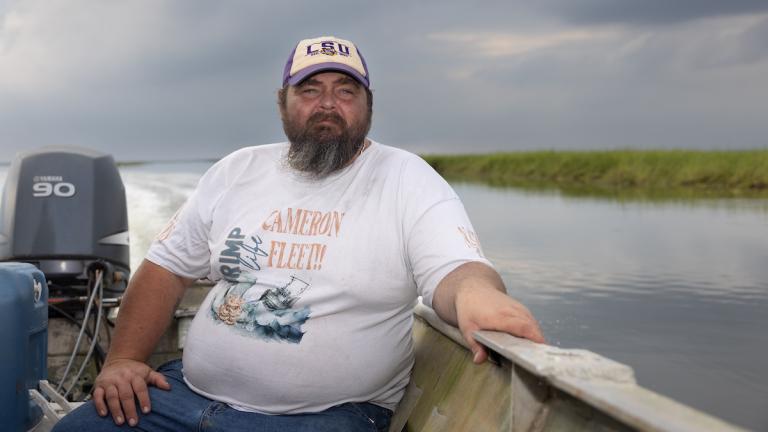Todd Paglia is the founder and director of The Paper Campaign at ForestEthics. When not working to protect forests, he’s often found on his road bike, far off in the distance.

Monday, 6 May 2002
SAN FRANCISCO, Calif.
It’s all around you. Right now as you read this it is probably covering your desk, bulging out of your file folders, encircling your coffee, creeping out of the fax machine, lurking in the photocopier’s innards, towering over you on the bookcase. It’s paper. And it is so ubiquitous we hardly notice it — but the environmental costs are extreme. Paper has become a little like hamburger: a high-volume business running on very tight margins. As a result, the producers will go to extremes to find cheap production materials from almost anywhere in the world. And the companies that sell the final product, like Staples, will do just about anything to make a buck.
That fascinating inter-office memo that has been on your desk for three weeks may have fiber from pesticide- and herbicide-laden plantations, from natural forests in the southern U.S., from your favorite national forest, from old growth trees in the Canadian boreal, or from the ancient forests of Indonesia. What it probably doesn’t have much of is recycled fiber. Although many people believe that the whole recycled paper thing was taken care of in the 1970s, in reality over 90 percent of paper made in the United States is from virgin tree fiber.
And don’t even get me started about the chemical and energy costs of paper. The paper industry is the second-largest industrial energy user in the U.S., and just the tons of bleaching agents used daily to make toilet paper a crisp Arctic white (does this seem strange to anyone else?) is staggering. Then there are the landfills where so much of this paper ends up. And the incredible experiment going on with genetically modified trees. Can I stop now?
All of which is why we, along with our partner organization The Dogwood Alliance and dozens of incredible allies, started The Paper Campaign. Our goal is to shift the U.S. market away from paper made from destroyed forests and toward recycled and alternative sources. Talk about job security, right? This is obviously a long-term campaign.

The young radical.
But I’m getting ahead of myself. Let me start at the beginning. That picture right there is of me, back when I was just an innocent little toddler growing up in upstate New York. The forest was my playground, where I hiked, hunted, fished, built lean-tos, explored, got lost, and found myself. As I grew up I saw the forest change, witnessed it literally disappear in some areas. This seemed pretty extreme to me — mowing down whole landscapes, destroying critical habitat, ruining rivers and streams, and leaving a massive scar on the land. So I went to work on the environment. And every day I go to work, I go back to the forests of my youth. Of course our office (in an alley in San Francisco’s Mission District) is not quite as picturesque, but you see what I’m saying.
You can imagine my surprise when I found out I was a radical. See, I don’t look terribly radical. I don’t even feel radical. Yet this is what the logging companies would have people believe. “Those damn radical environmentalists!” they scream. So here is my “extremist” platform: Let’s leave some trees standing. Industry sycophants are constantly saying that trees need to be cut in order to ensure forest health. Well, correct me if I’m wrong, but the forests seemed to do just fine for thousands of years without our “help.” We’ve already lost 95 percent of the old growth in the U.S.; do we have to compromise on the last 5 percent? Worldwide, almost 80 percent of all old-growth is gone. Let’s preserve some key natural areas, shift toward recycled paper, and improve logging practices. Sounds pretty conservative, right?
This is one on my mini-campaigns: to take the words “extremist” and “radical” back and put them right where they belong, firmly attached to Staples, International Paper, Georgia Pacific, George W. Bush, the U.S. Forest Service, and anyone else that advocates the alteration of whole landscapes to make cheap paper with public subsidies and environmental costs that will be passed on to our kids.
Tuesday, 7 May 2002
SAN FRANCISCO, Calif.
I am covertly writing this during a meeting. Meetings are one of my least favorite things in life, ranking right up there with going to the dentist. Especially multi-day meetings. Can you say root canal? You know the kind of meetings I’m talking about. By the end of the second day your eyes are so glazed over you can’t even blink anymore and you’re doing things like seeing how long you can hold your breath, just to try to keep yourself awake. But meetings are a little easier to sit through when you are plotting the transformation of one of the most polluting and environmentally damaging business sectors on Earth: the paper industry.
At this particular meeting, representatives from some of the leading groups working on paper markets are huddling together in San Francisco’s Presidio, slugging down massive amounts of coffee and even larger quantities of chocolate chip cookies while talking about paper and market campaigns. And I’m smiling. At a meeting, a two-day meeting no less, in a cramped room with those chairs that you can adjust into any position except the one that would make you comfortable.

Stopping Staples.
Here’s why I’m glad to be in this meeting: We’re trying to figure out how we can all work together more effectively. These are groups that have different approaches, that haven’t spoken to each other in years — everyone from the environmental movement’s Brahmins to the street fighters. If the paper industry bigwigs knew what was going on, they’d have a collective aneurysm.
You may be wondering what all this talk is about the marketplace, market campaigns, market this and market that. The sad fact is we live in a consumer society, and to me that means we ignore the marketplace at our peril and at great risk to the environment. Market campaigns are nothing new, but they have been gaining momentum in recent years; at ForestEthics, they are pretty much all we do. Forest protection work has traditionally been based on land trusts, litigation, legislation, or regulatory reform, and tree-sits, road blockades, and other means of protest where people put their bodies between a forest and a logging company.
Markets campaigns expand the toolbox. For almost every practice that harms the environment, there is a corporation behind it and a product or service on the market where you can try to establish accountability and reform. The development of such a campaign is part analysis and part alchemy, having to do with market share, leadership in a sector, heavy brand name investment, the possibility of victory, etc. Once you have the right sector and the appropriate lead target, the real work starts.
How do you influence your target? Talk to them first. Some companies want to do the right thing and they may be persuaded. We tried talking with Staples for 18 months and the company reps ignored us. So we went to work organizing a coalition to target the company and sent a letter announcing the national campaign. Suddenly there were three Staples vice presidents knocking on our door. They weren’t willing to make many changes, so the campaign went on — but we had their attention.

Michael’s nervous and the lights are bright.
Staples has spent hundreds of millions on its brand. To them it means a huge selection and cheap products. But where did all those cheap paper products come from? Mostly from trees, not recycled fiber. What we want people to do is associate Staples with forest destruction. (Some grassroots groups literally re-branded the company: Stumples). So in addition to continuing to negotiate with company managers, we work on the media, both paid and earned, we look for an internal champion, do lots of online activism to spread the word, encourage celebrity involvement, and organize national days of protest.
Thanks to an all-star organizing team and lots of great allies, last November we had the largest known day of action, with over 200 public demonstrations in the U.S. and Canada. Thanks to our partner the Dogwood Alliance, we have also done some public education work with the rock band R.E.M.
That photo is of me explaining a paradigm shift to Michael Stipe. (You can also see the public service announcement at the Paper Campaign website.) Why is R.E.M. involved in a market campaign? Here’s what they have to say about it: “Market campaigns, like this one being run by the Dogwood Alliance and ForestEthics, are one of the most effective way to cut to the chase and protect our forests.” I couldn’t agree more.
Wednesday, 8 May 2002
SAN FRANCISCO, Calif.
“Where’s Bill?” I ask. It’s 7:30 a.m., and we’re out here in the rolling hills of Sonoma County for a retreat with the Dogwood Alliance, our partner in the Paper Campaign. The Dogwood Alliance used to focus on legislative and regulatory campaigns to save southern forests; ForestEthics specialized in ancient forests and market campaigns. From the outside, we don’t exactly look like natural allies.

This is Bill.
But paper brought us together. Whether you’re talking about ancient trees in Canada, or endangered forests in the southern U.S., the paper industry is having an impact. In fact, it’s the largest industrial user of forests worldwide.
“Has anyone seen Bill?” I ask again. Everyone is bustling around, recovering from our late drive out here last night, downloading emails and getting ready for a full day of planning for the next phase of our campaign against office-products superstore Staples.
“He’s getting supplies,” says Kristi, our media director.
“Supplies,” I say. “What supplies do we need?” Just then the phone rings and after a few seconds of shuffling reports and notebooks, I find the receiver.
“Hello, this is Todd.”
“Hey, it’s Bill.”
“Where are you?”
Bill is the grassroots organizer for the Paper Campaign. Want to find an environmental activist in Grinnell, Iowa? How about Miami? Bill knows who you need to talk to, what their interests are, and how you can reach them. From his picture, Bill looks like Mr. Innocent.
Looks can be deceiving.

Bill goes undercover.
“I’m at Staples,” Bill says.
“What!? You’re getting supplies at Staples?!
“No, I’m on a scout.”
Yes, we actually do this sort of thing. Staples tells us it’s reforming its practices, but we can’t take their word for it. So every once in a while we go into a Staples store incognito and poke around — see what products are actually in the store, ask some questions, determine whether the employees have been given any training on recycled products and environmental issues.
This last element is key. We have scouted some Staples stores where the employees say there are no recycled products, only to find that there are a few (which we point out to them). Or they think most of the paper is recycled. It’s not. We point this out too. Bill likes doing the occasional scout. Maybe a little too much.
“What are you seeing?” I ask.

Bill checks out Staples stock.
“The usual, lots of signs heralding recycled content, but when you read the fine print, a lot of it is only 10 percent recycled, which means 90 percent virgin fiber. Thirty percent recycled is here too — but it’s the other 70 percent that’s the real problem. Not exactly a paradigm shift going on around here. At least the employees seem to know a little about the issues, but they’re definitely not lining up to tell the customers how their purchasing power can make a real difference for the environment.”
This is the sort of thing that gets a little frustrating. Here’s what Staples says: “Selling recycled products is a way of life at Staples and has been for years.” Yeah, right — just like telling the truth was a way of life at Enron. More and more, companies want to be able to claim that they are a friend of the environment without actually making any changes to reflect that mission.
It’s our job to hold their feet to the fire and demand accountability. We need to drive up the costs of greenwashing and do our best to hold companies responsible for what they do, what they say, and the gaping difference between the two.
Thursday, 9 May 2002
SAN FRANCISCO, Calif.
Sometimes I see in my mind’s eye a jousting contest, a King Arthur’s court, Knights of the Round Table sort of thing. The environmental movement is on one side of the medieval arena and the logging industry is on the other. The environmental movement picks its weapon — a beautiful handmade steel joust that is 12 feet long and glistening in the noonday sun — and rides out on a black stallion. The logging industry makes its picks. It can’t ride such a horse and it can’t heft around such a mighty jousting sword. The industry enters the stadium on a donkey wielding a rusty butter knife. Instead of celebrating and getting ready to kick some serious corporate butt, the environmental movement all too often starts looking for a way to trade down to be on a par with these pathetic wares. This is what the industry wants — for us to abandon our strengths and fight by their terms. Don’t do it. The messages we communicate must come back to our core issues — in our case, it’s the forest. And at ForestEthics, when it comes to message, I have to turn it over to Kristi Chester, our communications director:

Kristi Chester: communications cowgirl.
A year and a half ago, my environmental activism was a fly-by-night operation. I was running a design studio for environmental nonprofits in the cracks and crevices of time that existed around my full-time job as a graphic designer here in San Francisco. My job was great — I love designing — I just didn’t like doing it to help fill the overflowing coffers of corporations.
My desire to create a life’s work that moves us forward as a people and a planet forward felt compromised. So when ForestEthics offered me the position of communications director, I was overjoyed.
A year into the job and countless unpaid hours of insomnia later, it’s not my desire to do good that’s compromised, it’s my beauty sleep.
I’ve found that the price tag attached to the supreme fortune of being able to do what I love for a cause that I believe in can be measured in the minutes between 2 and 5 a.m. Somehow, I can’t stop thinking about how to get the issues that I work on out into the public’s eye. This sort of obsessive behavior seems to come with the territory when you’re dealing with activists.

The now-protected Great Bear Rainforest.
When I do get to sleep, I dream of getting Oprah to interview the two women at ForestEthics who went head-to-head with the industry big wigs in British Columbia and won, helping to win the protection of the largest tract of temperate rainforest in North American history. What better story? (Oprah, if you’re reading this, my number’s 415.863.4570.) Or how about R.E.M. doing the public service announcement for our paper campaign? I can see it now in the pages of People. Maybe Michael Stipe would consider going on location to an International Paper clearcut in North Carolina …
Whether you’re dealing with the clearcutting of massive amounts of native forests in Chile to make way for plantations of pine trees, or the purchasing practices of corporations like Staples, (which link directly to issues of public health, environmental justice, and ecosystem destruction), it’s impossible to put this work down and walk out the door at 5 p.m.
The more I’m exposed, the more urgent it becomes. It’s like putting your finger in the hole in dike, only to have another hole spout, and another and another. There’s so much destruction and so many battlegrounds, it’s impossible to ever feel like you’ve done enough.
Todd compares it to an epic battle, the environmentalists versus the corporations … It’s easy to feel that way, especially as I come to know more and more about the merciless exploitation of entire forests and communities. As the gatekeeper of the message, I always bring it back to the core issue — our fight is to protect forests and the people that depend on them. And we have no competing agenda.

The truth isn’t always clearcut.
When a company claims to be environmentally friendly because it plants three trees for every one it logs, it’s obscuring the truth, which is that a farm of trees is not the same as a forest; it’s the equivalent of calling astroturf grass. Often, these attempts at greenwashing are just a decoy to detract attention from the real costs of forest destruction — aerial herbicide spraying that’s increased 800 percent in the Southeastern United States in the past decade, 10,000-acre clearcuts, and tons of toxics being poured into our rivers and streams. We need to counteract industry’s attempts to obfuscate and battle its vacuous claims. But we can’t abandon the thing that the companies can’t defend themselves against: industrial-scale forest destruction. Bringing it back to the basics is what it’s all about, no matter how enticing or intellectually challenging the industry bait may be. What the industry wants — in this case, the logging industry — is to take everyone’s eye off the ball. Let’s bring it back to the basics and bear witness to what they are doing.
At the end of the day, after hours of conference calls and the circulation of the 26th draft of a press release, I close my laptop and remind myself why I do this work.
Sometimes it happens on the subway ride home, sometimes it happens during my walk on the beach with the dogs, but I always come back to that unshakable place inside myself, solid as a stone, that grows daily with the joy of doing the work that I believe in.
Friday, 10 May 2002
SAN FRANCISCO, Calif.
It is finally the end of a long week. I am up in Sonoma at the retreat center where we’ve convened to discuss the past, present, and future of the Paper Campaign — its successes, areas for growth, strategic plan for the next six months, etc. The work is the easy part; the emotional issues are what end up knocking you out. We all feel passionately about this work. In fact, most of us have walked away from mainstream careers that paid a lot more, offered a future of financial stability, required less work and far less psychic investment. But these jobs left us feeling empty inside. So the intensity level most of us bring to the work is fierce.

It’s the trees, stupid.
Add to this the fact that our task is more art than science, that we work thousands of miles away from one another and only come together a couple of times per year, that we have an infinitesimally small fraction of the funding available to our opposition, and you have a potentially explosive mixture. Consequently, a significant portion of the last few days was spent not only planning our actions for the next several months, but creating protocols for becoming more systematic in our interactions with one another. Communication and trust will be the key to our success — as they so often are in other areas of life — and we have spent a lot of time working on these issues.
The challenges are clear and at times daunting but I have no doubt we will win. As they say, the environmental movement is over and we won. Poll after poll shows that regardless of political affiliation, income level, religious beliefs, hometown, color, or creed, we all want clean air and clean water for ourselves and our children. That’s the good news. The harder part is converting these beliefs into actions, convincing people that their vote matters, that what they buy — or refuse to buy — makes a difference, that when corporations try to take away the things that are precious to us we need to hold them accountable. As Edward Abbey once said, “Sentiment without action is the ruin of the soul.”
After four straight days of meetings, late nights and early mornings, planning for the future and healing the wounds we have all experienced in the past, it’s time for a rest. So I’m going for a walk in the woods. For me, that’s what it always comes back to — the sun streaming through the trees, soft earth beneath my feet, the scent of cedar in the air, the cry of a hawk in the distance, and the future playing out before me, lush and vibrant.

